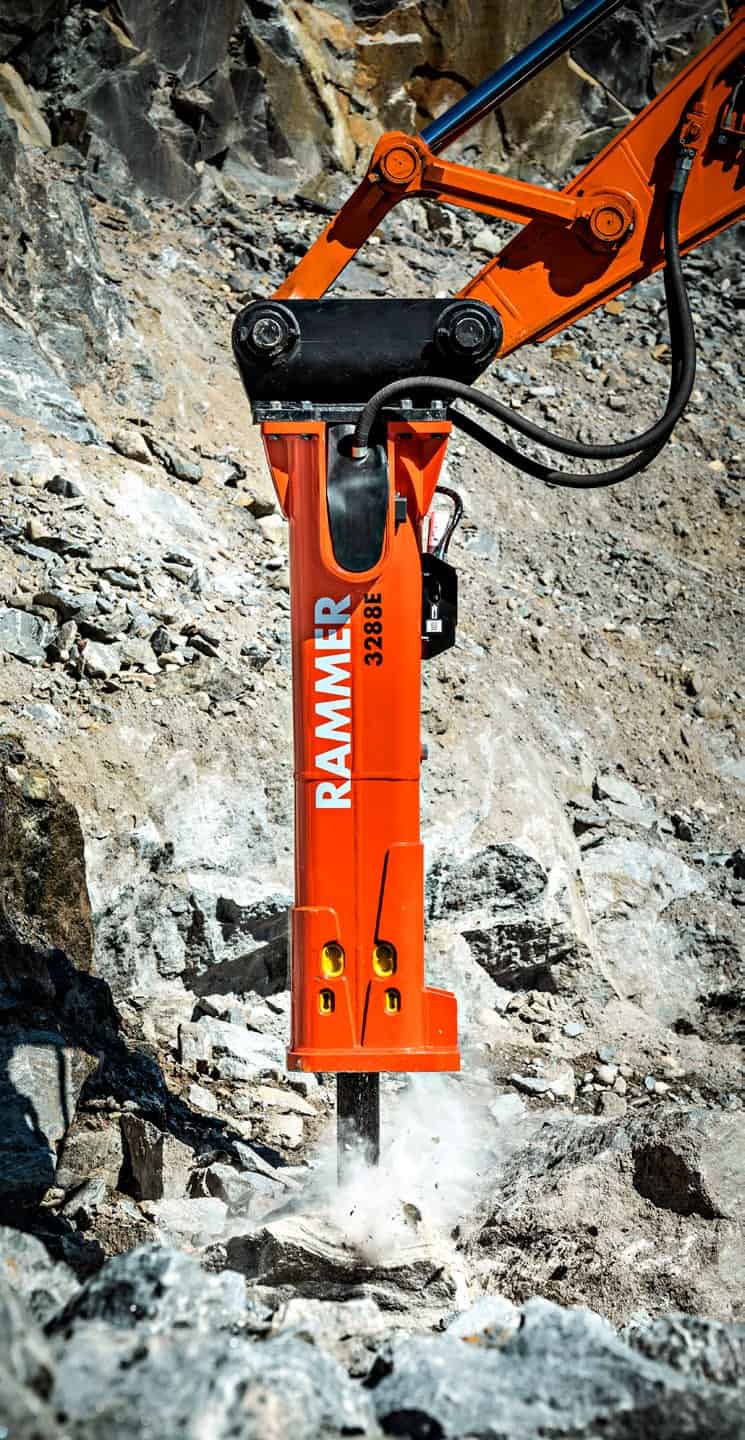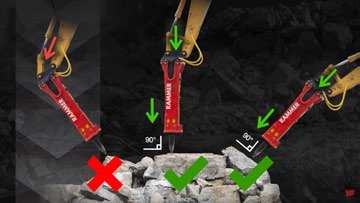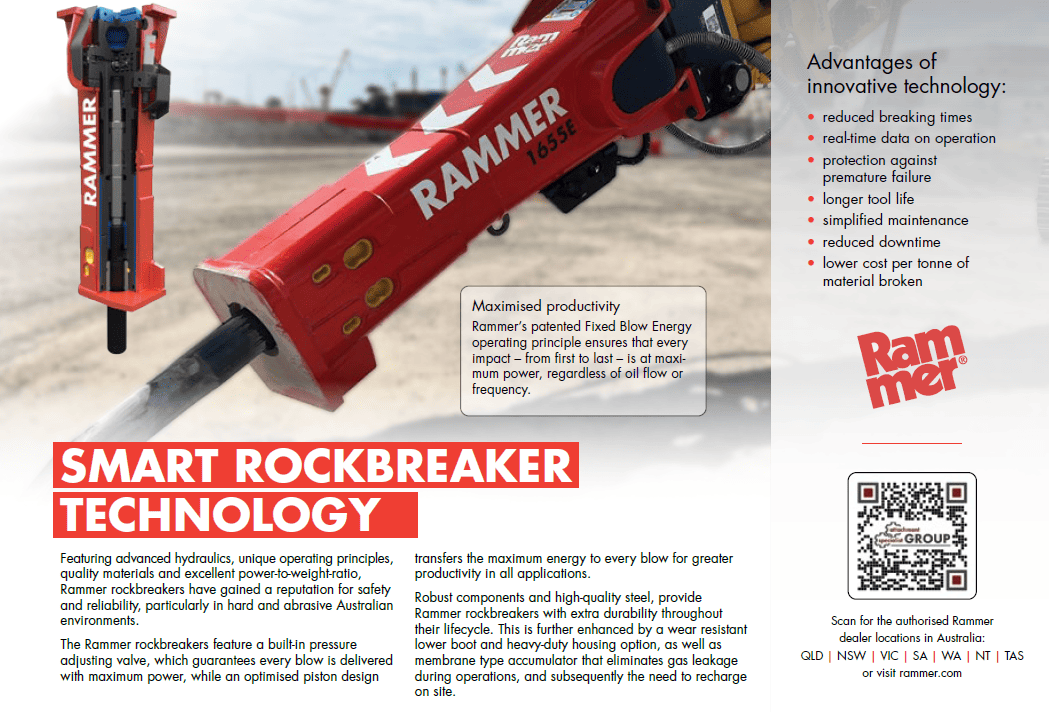Rockbreaking with Rammer®

Choosing the right tool for the job might seem an obvious approach for getting the best result but all too often a small mistake can result in a big problem.
When it comes to using the Rammer hydraulic rockbreaker, choosing the correct tool will not only boost efficiency but also prolong the life of the tool.
In order to do so, it helps to understand some basic principles. There are essentially two ways of breaking with a hydraulic rockbreaker, penetrative breaking, also known as cutting, and impact breaking.
Penetrative breaking involves using a chisel tool, or a moil point, which is then forced inside the material. This method is best employed for soft, layered or plastic, low abrasive material.
Additionally, it is important to note that the high impact rate of the smaller rockbreakers makes them ideal for penetrative breaking.
Impact breaking occurs when strong mechanical stress waves are transferred from the tool to the material that is to be broken.
This form of breaking is most effective when tackling hard, brittle, and very abrasive materials.
For impact breaking, the high impact energy of the large rockbreakers makes them ideal for impact breaking, with blunt tools achieving the best transfer of energy from the tool to the object. It should also be kept in mind that using the chisel tool will cause the sharp edge to wear quickly.
Jeff Jackson, Sales Manager and Director at Total Rockbreaking Solutions, said there is a very quick and simple principle to remember for selecting the correct tool for a rock breaking application.
“If the material that needs to get broken is still part of Australia (solid land), use the chisel tool and if it is blasted rock that needs to be broken into smaller rocks, use the blunt tool,” Mr Jackson said.
Expanding on this principle, Mr Jackson said he has seen a few common operator errors that could have easily been avoided.
The first results when operators attempt to use the tool as a lever, like a crowbar.
This essentially occurs when operators strike into concrete or hard ground and then pry with the tool at the same time.
The impact of using the tool as a lever can result in it bending or breaking, which can easily be avoided by stopping when resistance is felt.
Similarly, the rockbreaker tool should not be used for moving rocks as this function can be effectively performed by the stone claw tool.
The second common mistake Mr Jackson has seen over his more than 10 years with Total Rockbreaking Solutions occurs when operators do not use the rock breaking tool at the correct angle.
The tool should be used at a 90-degree angle with the surface of the material to be broken.
If the operator notices that the angle has changed following im-pact, the operator should correct the angle, returning it to 90 degrees, before recommencing the breaking operations.
Moving away from the optimal 90-degree angle and continuing to operate the tool can result in damage to the tool, including wearing out bushings faster.
A third key error Mr Jackson has seen from operators is using the tool for extended cycle times, such as striking in one place for more than 15 seconds at a time.
Hitting one spot for an extended can cause dust to build up under the tool which can dampen the impact effect and result in excessive heat.
If the object does not break, or the tool does not penetrate the material, the operator should stop the rockbreaker and change the position of the tool.
And, to further prolong the life of your rockbreaking machinery, regular maintenance and proper storage are vital.
Visual inspections & greasing practices
 Preventing unnecessary downtime through proper rockbreaker maintenance and service schedules is critical in mining applications. Rammer is committed to helping operators work safer and more productively, whilst keeping their rockbreakers in optimal condition.
Preventing unnecessary downtime through proper rockbreaker maintenance and service schedules is critical in mining applications. Rammer is committed to helping operators work safer and more productively, whilst keeping their rockbreakers in optimal condition.
Greasing, particularly keeping the tool shank well-greased during operation, is a highly recommended maintenance strategy.
The right amount of grease depends on rockbreaker size, application, working cycles, wear rate of the tool shank and bushings, condition of the tool seal, and quality of the grease used.
The rockbreaker tool should be checked every two hours to ensure it is sufficiently greased, including the automatic grease cartridge. Operators should monitor hydraulic oil temperature, and ensure all lines and connections are secure.
The mounting hardware on the rockbreaker and carrier should be checked and tightened if required.
Every 50 hours or at least once a month, the tool shank and bushings should be inspected for wear. If the grease grooves on the tool bushing are worn, the bushing must be replaced.
Hydraulic hoses should be regularly checked and replaced if necessary, and that the rockbreaker moves normally inside the housing, and vibration dampening elements such as pads and buffers are in good condition. The condition of wear pads and internal housing wear also require inspection.
It is also advised that operators avoid using a rockbreaker with the tool submerged underwater unless previously setup for such an application.
Regular visual inspections of the rockbreaker and its components are essential.
Short & long-term storage
To protect the rockbreaker when not in use, the tool should be removed and the rockbreaker itself stored in a vertical position.
The lower end of the piston tool and tool bushings can be protected with grease.
Connections should be sealed with clean plugs to prevent oil leakage and dirt from getting into the couplings. It is also important that the rockbreaker is appropriately secured to prevent it from falling.
Preventative maintenance
The integration of Rammer’s world-first RD3 hydraulic rockbreaker monitoring technology is an effective method for operators to remotely monitor rockbreaker usage and prevent premature failure. It provides operators with detailed information in real-time via the cloud based SAM platform, allowing them to manage service periods and minimise machinery downtime by scheduling maintenance during times that have minimal impact on production.
Product Line Lifecycle Manager for Rammer Rockbreakers, Esa Sjönberg says it’s no surprise that their large rockbreaker range is a reliable choice for miners due to the robust components and high-quality steel used, which offer extra durability throughout the breaker lifecycle.
“Despite our innovative manufacturing processes and high-quality materials, maximising rockbreaking effectiveness relies on correct working methods and maintenance that not only improve productivity, but help operators increase their equipment service life. That’s why our team is dedicated to educating operators on how to achieve the most from their rockbreakers.”
Unrivalled performance
For over 40 years, Rammer rockbreakers have proven the reliable solution for the toughest mining, quarrying and demolition applications. The company knows that getting the most out of your rockbreakers comes down to more than just the right product. It requires an in-depth knowledge of the science behind the product, its materials and components, which all combine to maximise service life.
Featuring advanced hydraulics, quality materials, and excellent powerto- weight ratio, Rammer rockbreakers have gained a reputation for safety and reliability, particularly in hard and abrasive Australian environments.
Their flagship rockbreakers and hydraulic booms are purpose-built to work safely and efficiently. From major excavation and clearing works, to the effortless breaking of hard rock, concrete, reinforced structures, asphalt surfaces, or even frozen ground, Rammer rockbreakers are designed for power and productivity in the most challenging conditions.
For more information, or to locate your nearest dealer, visit www.rammer.com
Rammer authorised dealer network in Australia
- VIC/SA/TAS: Walkers Hammers
- NSW: Groundtec
- QLD, NT, PNG: QLD Rock Breakers
- WA: Total Rockbreaking Solutions























